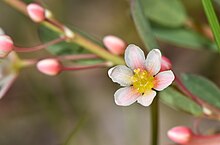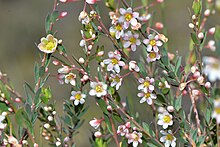| Phyllanthus calycinus | |
|---|---|

| |

| |
| Scientific classification | |
| Kingdom: | Plantae |
| Clade: | Tracheophytes |
| Clade: | Angiosperms |
| Clade: | Eudicots |
| Clade: | Rosids |
| Order: | Malpighiales |
| Family: | Phyllanthaceae |
| Genus: | Phyllanthus |
| Species: | P. calycinus |
| Binomial name | |
| Phyllanthus calycinus Labill. | |

| |
| Occurrence data from Australasian Virtual Herbarium | |
| Synonyms | |
|
List of synonyms
Clutia berberifolia Pax | |
Phyllanthus calycinus, known as false boronia and snowdrop spurge, is a small shrub in the family Phyllanthaceae, which grows to heights from 20 cm to 1.2 m, often on sandy soils. It is found in both Western Australia and South Australia. In Western Australia its white-cream to pink flowers may be seen from June to January, and in South Australia, from May to October.
Description
From the key given in Hunter and Bruhl (1997), the following partial description (differentiating it from other Western Australian Phyllanthus species) is derived: The leaves are normal but sometimes reduced. The plant is monoecious. The branchlets are smooth. The sepals of the female flower enlarge to enclose the fruit, which is from 3 to 5.2 mm by 5 to 6 mm, and encases seed which is from 2.5-3.9 mm by 1-8-2.5 mm.
Taxonomy and naming
It was first described in 1806 by Labillardière. The specific epithet, calycinus, is Latin meaning "with a well developed calyx".
References
- ^ "Phyllanthus calycinus". Australian Plant Name Index, IBIS database. Centre for Plant Biodiversity Research, Australian Government.
- ^ Labillardiere, J.J.H. de (1806) Novae Hollandiae Plantarum Specimen 2(23): 75, t. 225.
- Phyllanthus calycinus occurrence data from Australasian Virtual Herbarium
- "Phyllanthus calycinus Labill. | Plants of the World Online | Kew Science". Plants of the World Online. Retrieved 2019-09-01.
- ^ "eFloraSA: Fact sheet for Phyllanthus calycinus". www.flora.sa.gov.au. Retrieved 2019-09-01.
- ^ "Phyllanthus calycinus". FloraBase. Western Australian Government Department of Biodiversity, Conservation and Attractions.
- Hunter, J.T., Bruhl, J.J. (1997) Three new species of Phyllanthus (Euphorbiaceae: Phyllantheae) for the Northern Territory, one new species for Western Australia, and notes on other Phyllanthus species occurring in these regions, Nuytsia 11, 147-163. Retrieved 2 September 2019.
- Stearn, W.T. (2004) "Botanical Latin" (4th Ed) p. 380, Timber Press, Oregon. ISBN 9780881926279
| Taxon identifiers | |
|---|---|
| Phyllanthus calycinus | |
